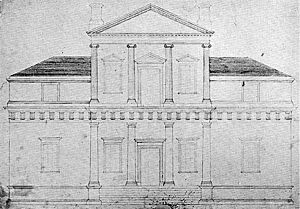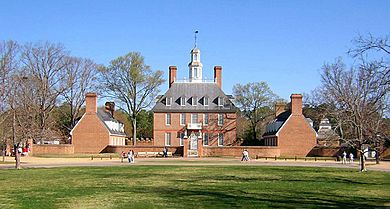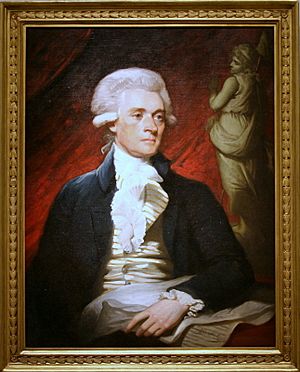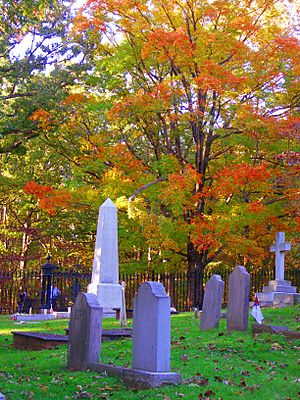Martha Jefferson facts for kids
Quick facts for kids
Martha Jefferson
|
|
|---|---|
| First Lady of Virginia | |
| In office June 1, 1779 – June 3, 1781 |
|
| Preceded by | Dorothea Henry |
| Succeeded by | Anne Fleming |
| Personal details | |
| Born |
Martha Wayles
October 30, 1748 Charles City, Virginia, British America |
| Died | September 6, 1782 (aged 33) Charlottesville, Virginia, U.S. |
| Spouses | |
| Children |
|
| Parents |
|
Martha Skelton Jefferson (born Wayles; October 30, 1748 – September 6, 1782) was the wife of Thomas Jefferson. She was the First Lady of Virginia. This was during Jefferson's time as governor from 1779 to 1781. Martha died in 1782, 19 years before Thomas became president.
Thomas and Martha had six children. Sadly, only two daughters, Martha and Mary, lived to be adults. Martha died just four months after her last child was born. Many letters between Martha and Thomas were destroyed. It is not known who burned them. Thomas rarely spoke about her, so much about her life remains a mystery.
Contents
Discovering Martha Jefferson's Early Life
Martha Wayles was born on October 30, 1748. She was the only child of Martha Eppes Wayles and John Wayles to survive. Her birth took place near Colonial Williamsburg in Charles City County, Virginia. Her mother had twins before Martha, but they did not live. Martha was often called "Patty" by her family.
Martha's Family Background
Her father, John Wayles, came from Lancaster, England. He was a successful planter and an attorney. He also owned many slaves. Martha's mother, Martha Eppes Wayles, loved reading. She enjoyed books like Tristram Shandy.
Martha had two stepmothers, but they both died soon after marrying her father. Through one stepmother, she gained four half-sisters. One of these half-sisters was Elizabeth, who married Martha's cousin, Francis Eppes. Their son, John Wayles Eppes, later married Thomas Jefferson's daughter, Mary.
After his third wife died, John Wayles had children with Betty Hemings, a woman who was enslaved. These children were Martha's half-siblings. The youngest of them was Sally Hemings, born in 1773.
Martha's Education and Responsibilities
Martha likely learned from private teachers at home. She studied literature, dance, music, French, and the Bible. When she was 13, her second stepmother died. Martha then became the "Lady of the House." She helped her father manage his home and business. She also hosted his social events. Martha knew how to make everyday items like candles, soap, and butter. She also knew how to prepare home remedies for illnesses.
Martha's Marriages and Children
Martha Wayles first married Bathurst Skelton, an attorney, on November 20, 1766. She was 18 years old. Their son, John, was born in November 1767. Sadly, Bathurst Skelton died in September 1768. Martha moved back home. Their son John also died in June 1771, at age three.
Marriage to Thomas Jefferson
Martha's third cousin, Thomas Jefferson, began spending time with her in December 1770. They both loved horse riding, reading, and music. They married on January 1, 1772. As part of Martha's dowry, Thomas received land and many enslaved people. This helped him finish building his home, Monticello. It also helped with the landscaping of his 5,000-acre estate. While Monticello was being built, Martha often stayed at the Elk Hill plantation.
Children of Martha and Thomas
Martha and Thomas had six children together. Sadly, only two of their daughters lived to adulthood. An unnamed son, Jane Randolph, and two daughters named Lucy Elizabeth died when they were very young. Only their oldest daughter, Martha "Patsy" Jefferson, lived past age 25.
- Martha "Patsy" Jefferson (born September 27, 1772 – died October 10, 1836)
- Jane Randolph Jefferson (born April 3, 1774 – died September 1775)
- Unnamed son (born May 28 – died June 14, 1777), lived for 17 days
- Mary "Maria or Polly" Jefferson (born August 1, 1778 – died April 17, 1804)
- Lucy Elizabeth Jefferson (born November 3, 1780 – died April 15, 1781)
- Lucy Elizabeth Jefferson (born May 8, 1782 – died around October 13, 1784)
Enslaved People and Wayles' Estate
Martha and Thomas Jefferson gained many enslaved people through her marriage and from her father's estate. This made Thomas one of the largest slave owners in Albemarle County. His number of enslaved people grew from 52 to 187.
Among these enslaved people were Betty Hemings and her ten children. Betty's youngest child was Sally Hemings. Six of Betty's children were Martha Wayles Jefferson's half-siblings, as their father was John Wayles. The Hemings family members had special roles at Monticello. They worked as house servants, chefs, and skilled craftspeople.
When Martha's father, John Wayles, died in 1773, he left a lot of property, including enslaved people. However, his estate also had many debts. Betty Hemings and her six children with John Wayles were moved to Monticello. This was done to keep the Hemings family together. The estate was worth a lot of money, but it owed a large debt to a company in England. Thomas Jefferson and his brothers-in-law decided to divide the estate and its debts. Martha and Thomas inherited two plantations and 135 enslaved people, including members of the Hemings family. They also inherited a large debt. This debt caused Thomas Jefferson many financial problems for years.
Martha's Personality and Appearance
No paintings of Martha Jefferson from her lifetime exist. However, family members described her as small, graceful, and pretty. She was said to look like her daughter, Mary Jefferson Eppes. Her sister's husband, Robert Skipwith, said she had "the greatest fund of good nature." He also noted her "sprightliness and sensibility."

Thomas Jefferson bought a piano forte from England for Martha as a wedding gift. She played the harpsichord very well. Thomas played the violin. A visitor to Monticello in 1780 said Martha was "a very agreeable sensible and accomplished lady."
According to her daughter, Martha Jefferson was well-educated and loved music. She was always reading. She had a kind nature, but sometimes she could be a bit sharp. She loved her husband very much. She was a little over 5 feet tall, with a slim build, reddish-brown hair, and hazel eyes. Martha was also skilled at needlework. Some of her embroidery still exists today. She kept notes on her household duties and recipes. These included how to prepare meat and make large amounts of soap, candles, and beer. In her first year of marriage, she made 170 gallons of beer.
First Lady of Virginia

Martha Jefferson served as the First Lady of Virginia from 1779 to 1781. This was during the American Revolution. She helped raise money and supplies for Virginia's soldiers. This was in response to a request from Martha Washington. Martha Jefferson published an appeal in the Virginia Gazette. She announced that collections would be taken in churches. She also contacted other important Virginians to raise funds for the troops.
Health Challenges and Death
Managing the Jefferson household became very hard for Martha. She had suffered from smallpox. She may also have had diabetes. Her health was weakened by her many pregnancies. She also had to deal with the stress of wartime. She fled a British invasion of Richmond in 1781. She also had to escape a raid on Monticello in June of that year. During these times, she traveled with her young children, many of whom later died. She knew the British wanted to capture her or her husband.
Thomas Jefferson limited his political work because of Martha's health. He wanted to return to her as soon as possible. He was in Philadelphia for the Second Continental Congress in 1776. This was where the Declaration of Independence was written. Thomas served as governor and in the House of Delegates. He turned down an offer to serve as a commissioner to France while Martha was alive.
The birth of their youngest child in May 1782 was very difficult for Martha. Her health got worse, and she died on September 6, 1782. This was four months after her last child was born. She was buried at Monticello. Her tombstone includes words from Thomas: "Torn from him by death" and "This monument of his love is inscribed."
Martha asked Thomas Jefferson to never marry again. She did not want her children to grow up with stepmothers. She had difficult experiences with her own stepmothers. Thomas never remarried. Martha was 33 when she died, and Thomas was 39.
See Also
In Spanish: Martha Jefferson para niños



